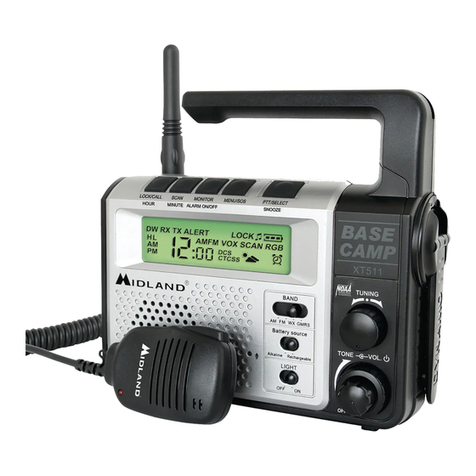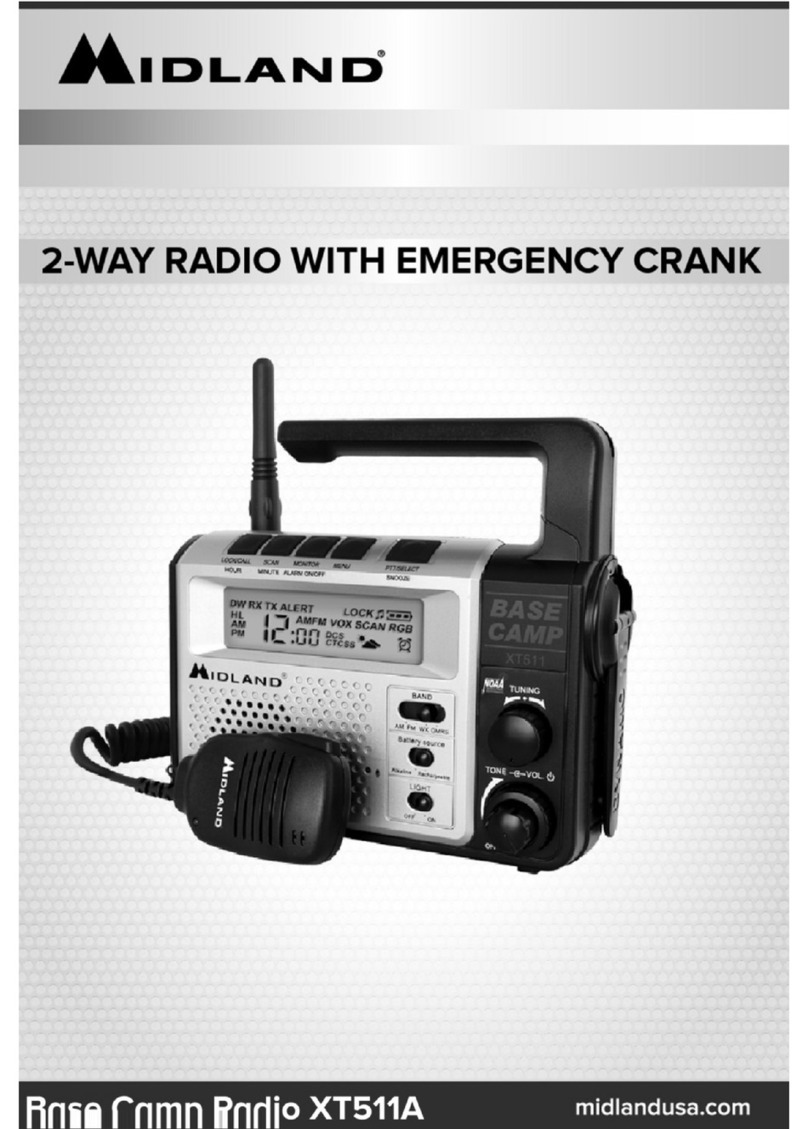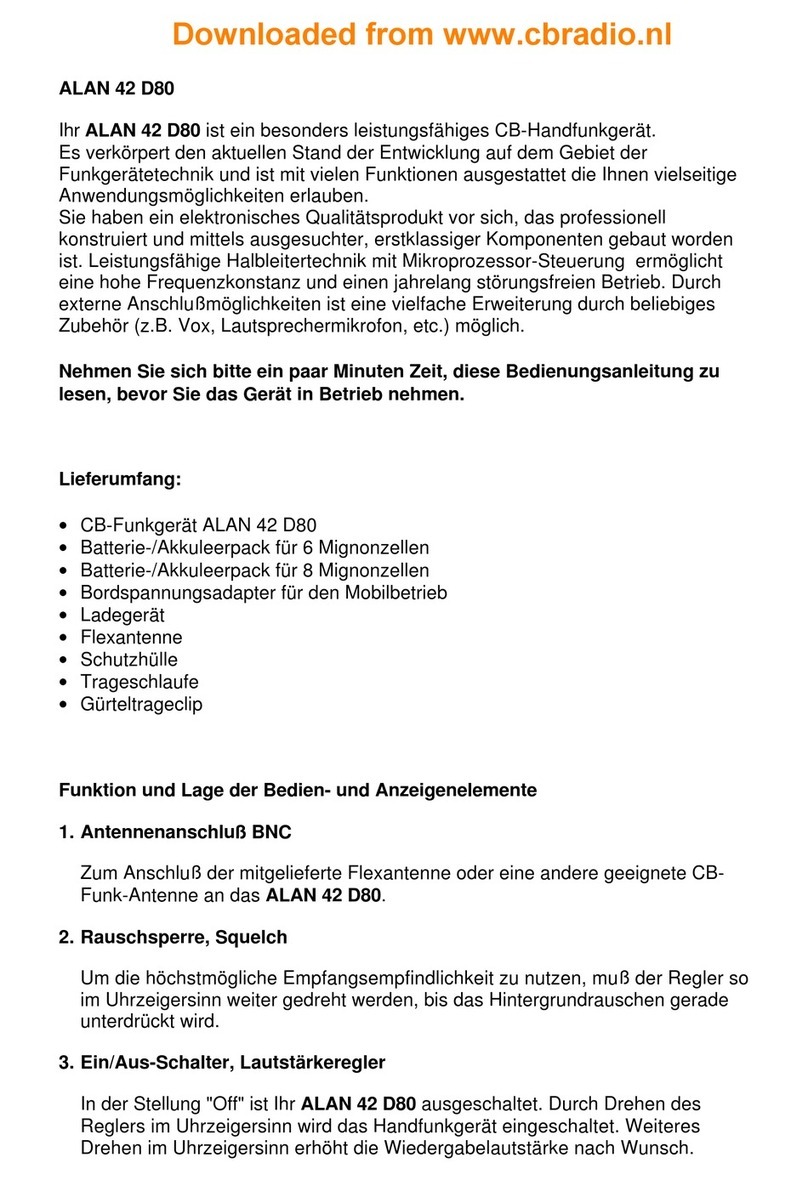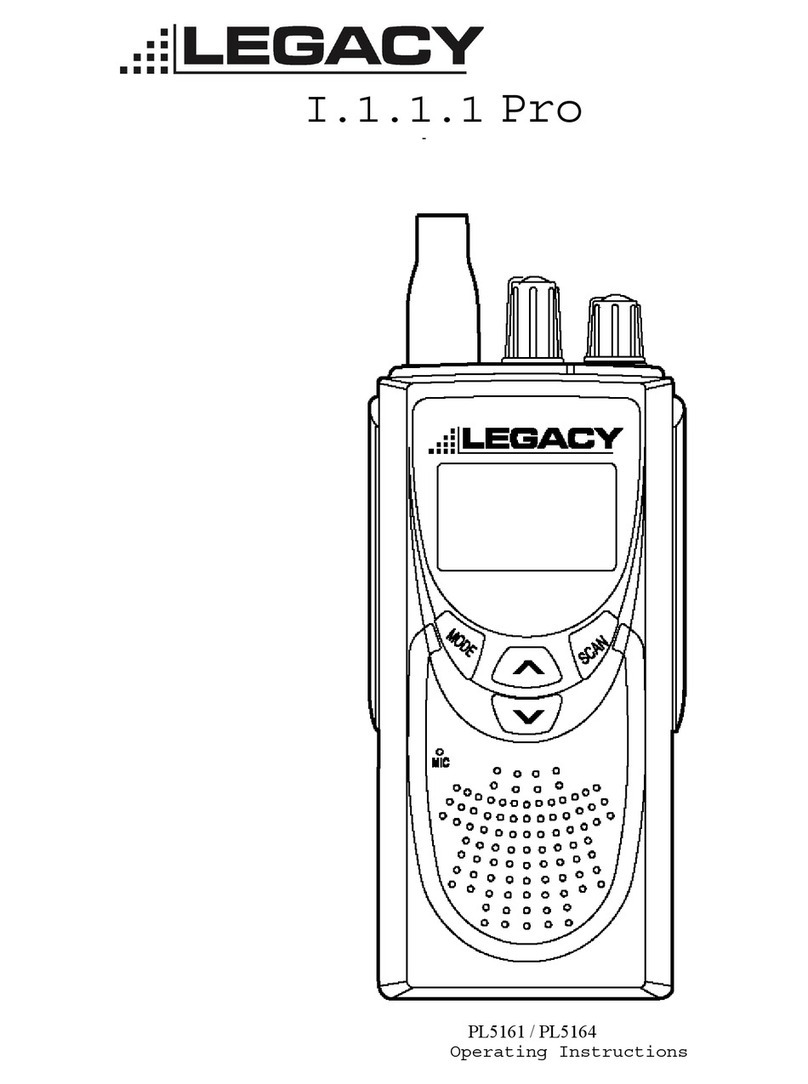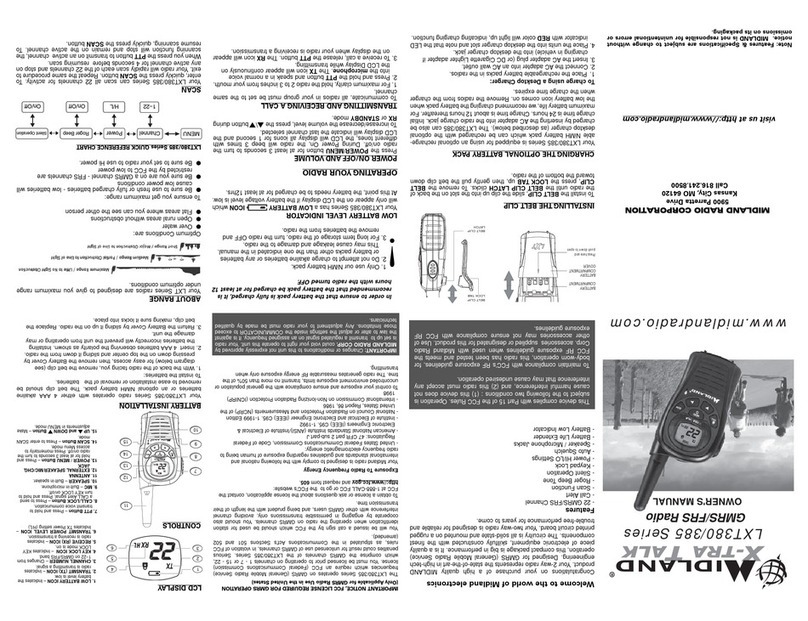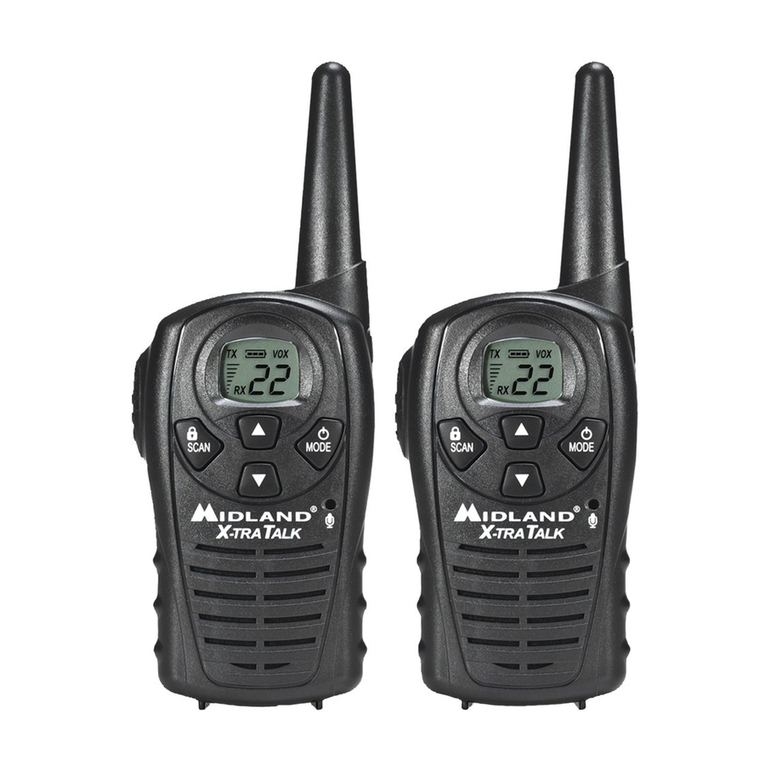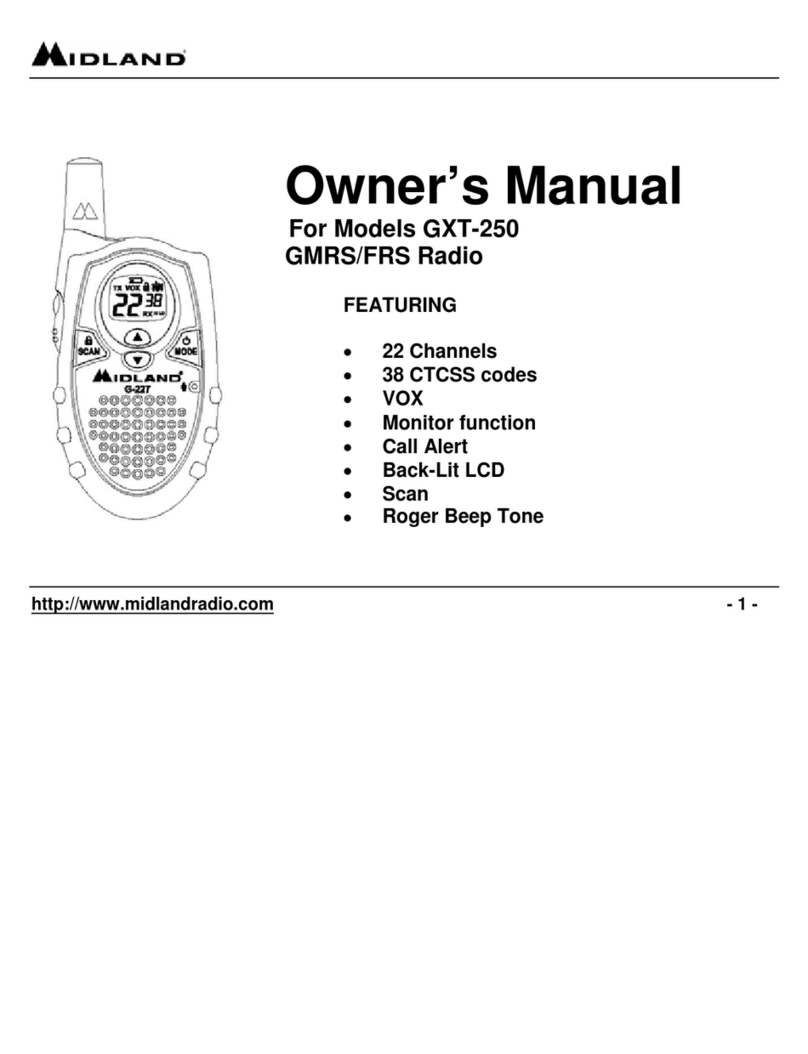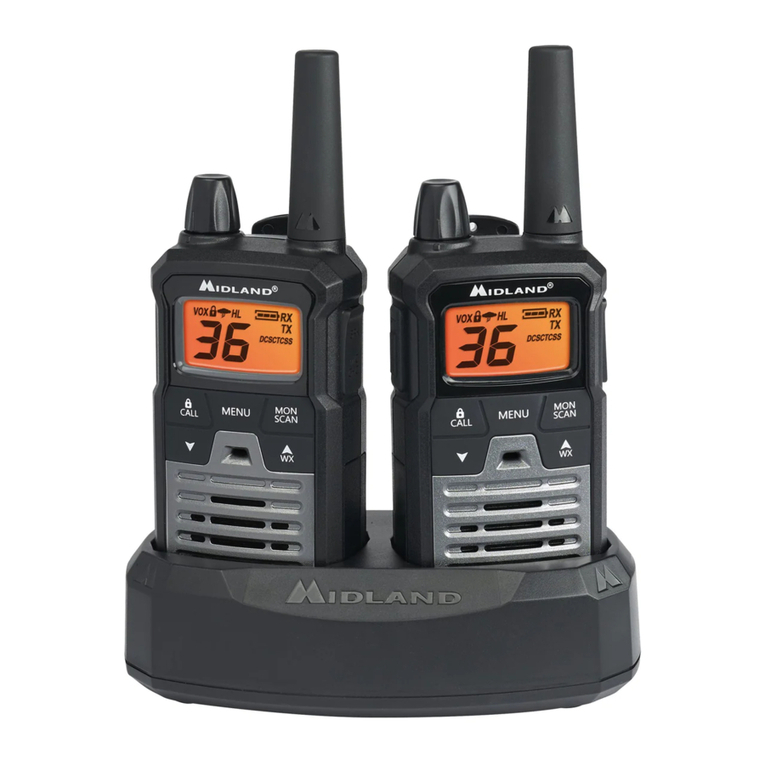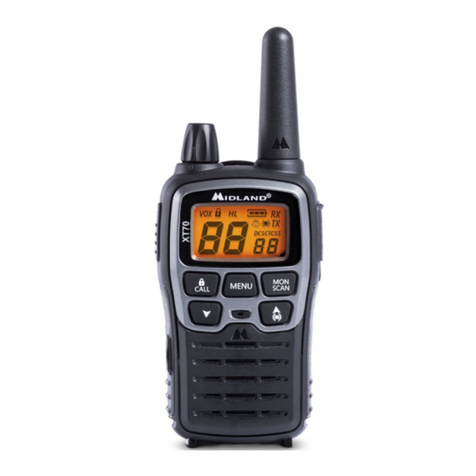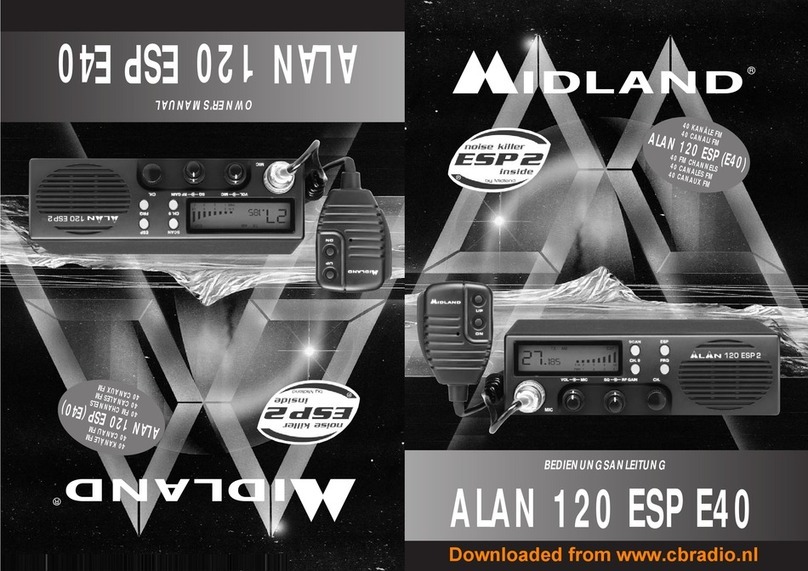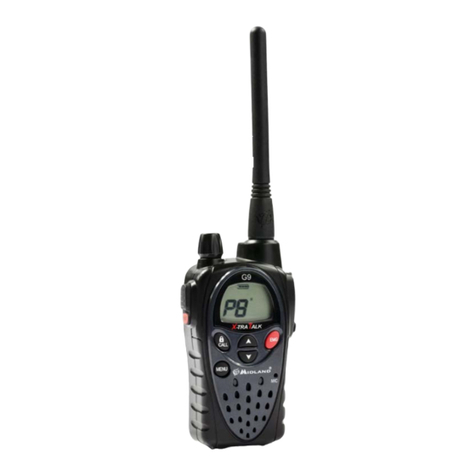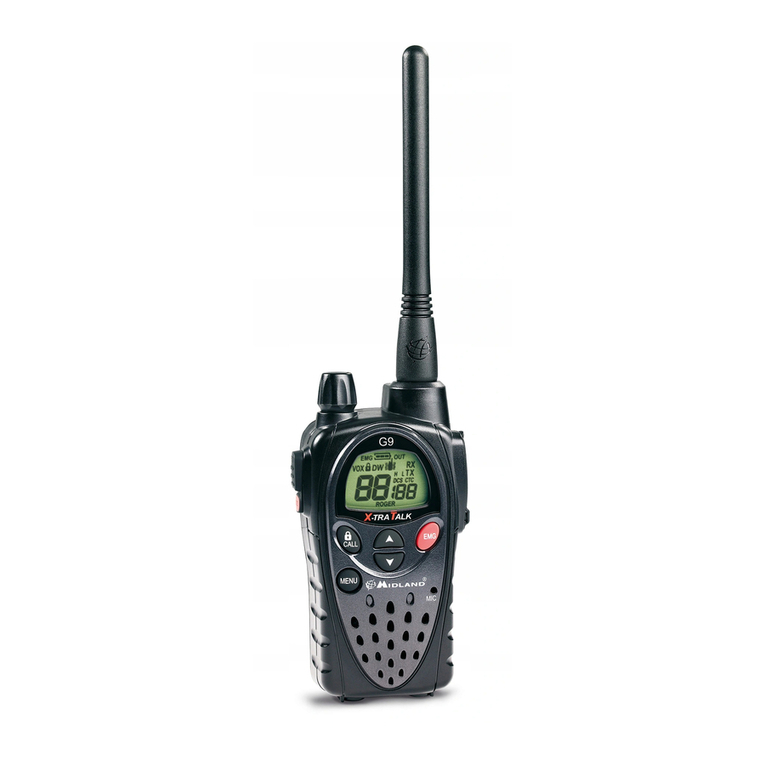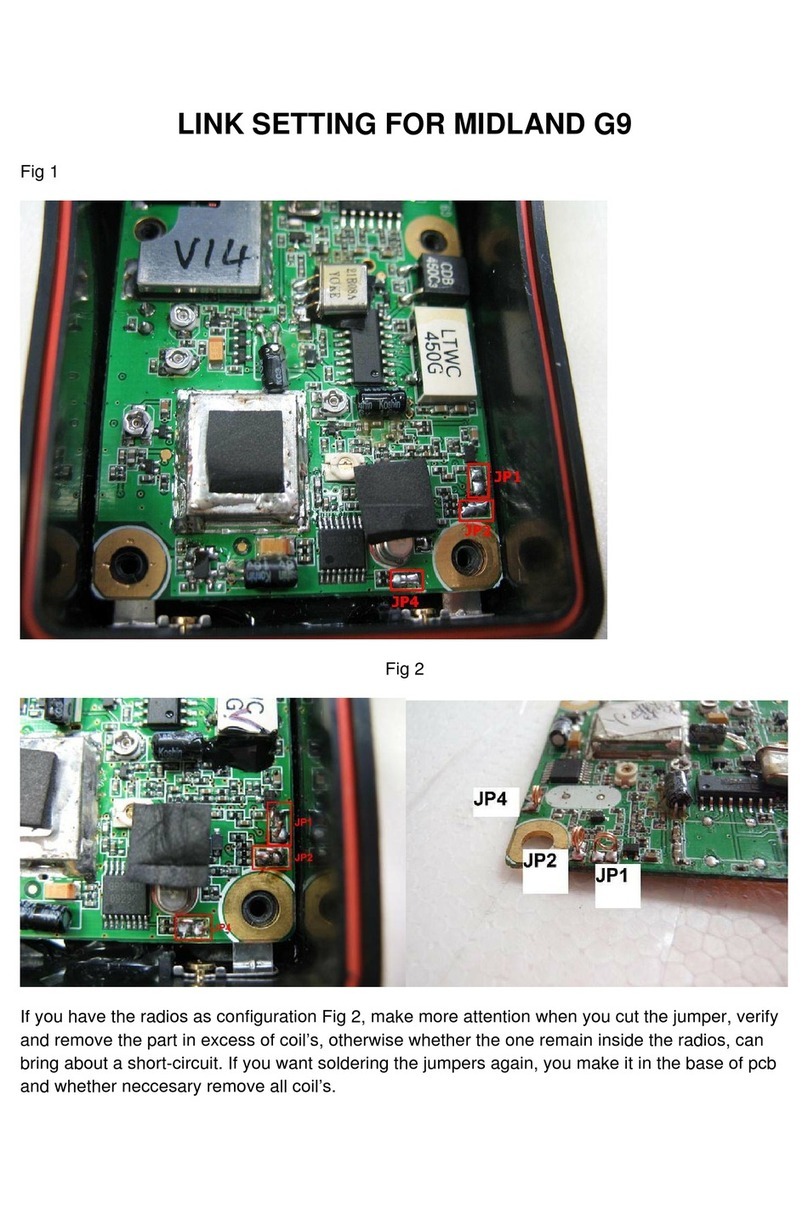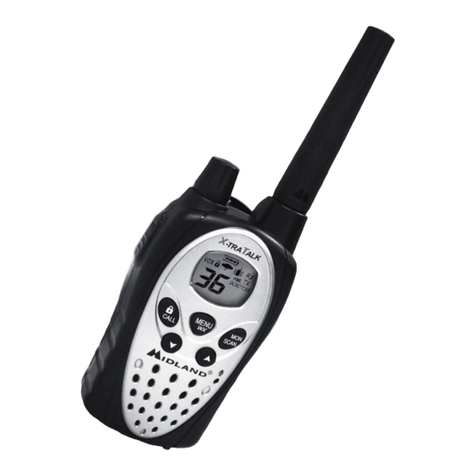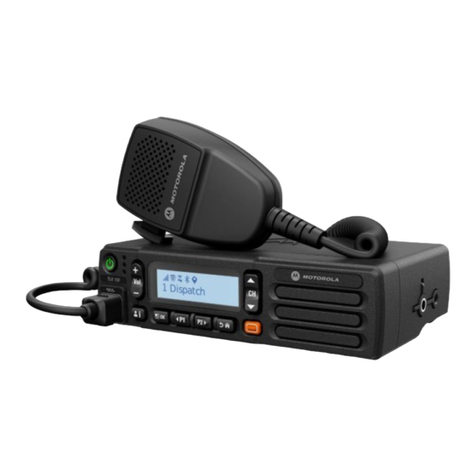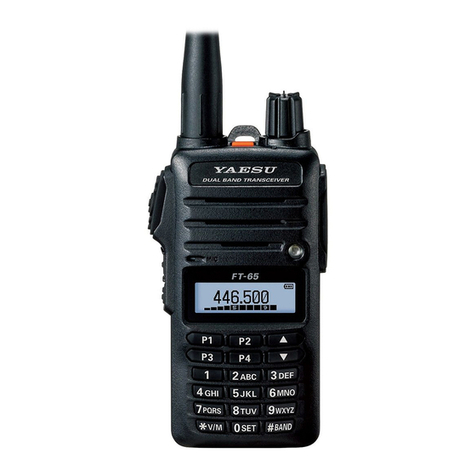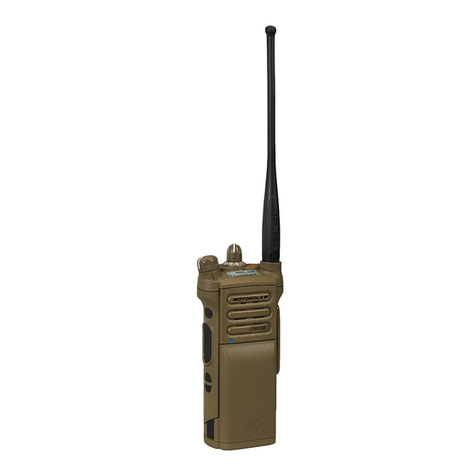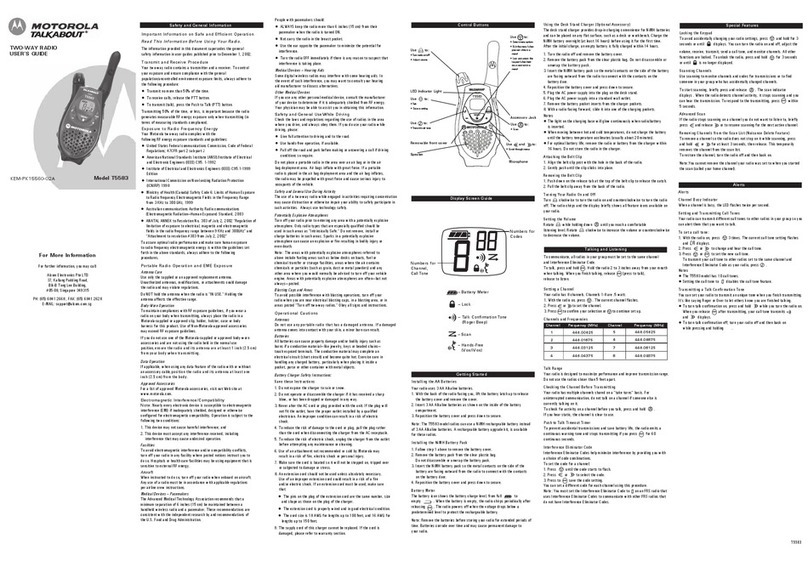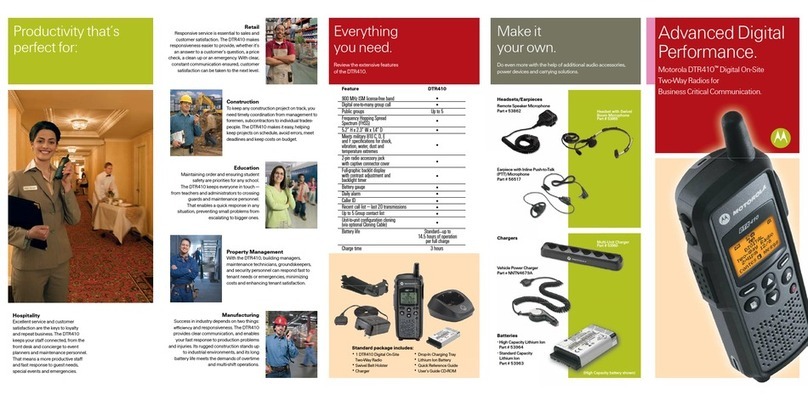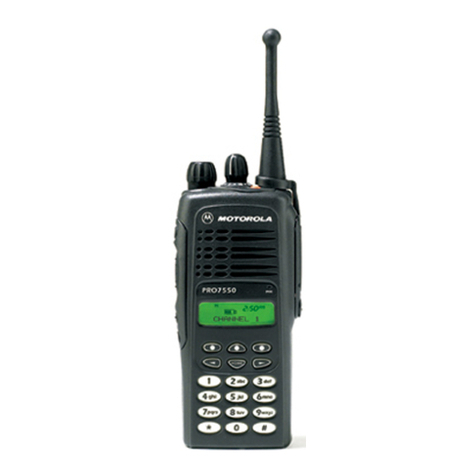7. H (High) / L(Low) - shows the high or low power selection (PMR band).
8. RX - (busy channel): appears on the display when the transceiver is receiving a signal.
9. CTCSS tones - these 2 small digits indicate the selected CTCSS tone (1 - 38).
3.2 Radio
Refer to the this picture to identify the various parts of the device:
10. VOLUME knob - On/off switch for the device and adjusts
volume of reception.
11. PTT button (push to talk) - Press this button to transmit.
12. CALL/ button - to send a call on the selected channel.
If you keep it pressed for about 5 seconds, the keypad
lock is activated.
13. Built-in MICROPHONE - Here is where sound is picked
up by the microphone.
14. Built-in SPEAKER - Here is where the speaker is
housed.
15. ANTENNA - Receives and transmits radio signals.
16. SPK/MIC socket (under protective cover) - To connect
to external audio devices (headphones, microphone etc.)
and to the battery charger.
17. MENU button - Press this button to display the device’s
menu.
18. MONITOR/SCAN button- Press this button once to
activate SCAN (scanning of channels). Keep the same
button pressed for about 2 seconds to activate MON
function. This function temporarily cuts off Squelch (for
weak signals).
19. Scroll buttons / - Press these buttons to change
setting within the MENU.
4. PREPARING THE TRANSCEIVER
Make sure the following items are supplied in the package before you start using your
transceiver:
2 transceivers; double desktop charger; wall adaptor; 2 battery packs, 800m A/h NiMH; belt
clip; operational manual.
If any of the above is missing or damaged contact your supplier immediately.
4.1 Battery pack recharge
The supplied battery pack is 6V NiMH type and must be recharged without taking it out of the
transceiver; it takes 12 -14 hours to fully recharge.
To recharge the battery pack:
1. Connect the socket of the wall adaptor to a mains power socket and insert the jack of the wall
adaptor into the desktop charger plug.
2. Place your transceiver into the cradle of the desktop charger.
3. When charging is complete take the transceiver out of the cradle and detach the socket of the
wall adaptor from the mains.
! Do not overcharge the batteries! When these are fully charged the charging process
does not stop automatically. Do not forget therefore, to remove the transceiver from the
charger as soon as the batteries are charged.
! Do not try to charge alkaline batteries or non rechargeable batteries. Make sure that
when you charge the radio, only rechargeable batteries NI-MH should be contained
in the battery compartment! It is very dangerous attempting to recharge other types
of batteries (for example alkaline or manganese batteries). Batteries which are not
suitable to be recharged may leak, explode or even burn and cause damage!
! Using a different battery charger other than the one specified can cause damage to
your device or may even cause explosions and personal injuries.
! Do not throw batteries into fire or place them near heat as this may cause explosions
or personal injuries. Dispose of the batteries according to procedures set out by local
regulations.
! Do not mix old and new batteries or batteries of different types or batteries which have
been used in different manners.
4.2 Memory effect of rechargeable batteries
Rechargeable NiMH (Nickel-Metal-Hydrate) batteries are affected by what is known as the
“memory effect”. This phenomenon is associated with a drastic reduction of battery autonomy
and is triggered if the batteries are regularly charged before being fully discharged and/or are not
completely recharged. To avoid the memory effect:
• When possible, recharge the batteries only when they are completely discharged (until the
device turns itself off during normal use)
• Do not disconnect the battery charger before the time indicated for a full battery charge.
• Discharge and recharge your batteries completely at least twice a month. In any case, the best
solution for avoiding the memory effect is to use in turn two battery sets: one in use, and the
other as a spare set.
The memory effect can be easily eliminated by completely discharging/charging the batteries 3
or 4 times.
The memory effect should not be confused with the normal battery life, which is 300-400
cycles of charge/discharge on average. It is completely normal for operating duty to decrease
when the batteries have reached the end of their life; at this point, you will need to substitute
the batteries.
4.3 Installing and removing the belt clip
With the belt clip you can easily attach the transceiver to your belt. The clip however, must be
removed in order to install or change the batteries. To remove the belt clip follow the instructions
of picture 1. To fix the clip back to the device slot it in the guides at the back of the transceiver
until it clicks into place.
4.4 Installing/removing the battery pack
4.4.a Removal
1) Remove the belt clip as explained in
paragraph 4.3;
2) Open the battery compartment as shown
in picture 2;
3) Remove the battery pack;
4) Replace the battery cover and fix the belt
clip.
4.4.b Installation
1) Remove the belt clip as explained in
paragraph 4.3;
2) Insert the battery pack into the battery
compartment;
3) Replace the battery cover and fix the belt
clip.
Midland G7
Two-colour and dual band PMR/LPD transceiver
1. INTRODUCTION
Combing the latest technology in radio communication along with a sturdy mechanical frame,
the MIDLAND G7 makes the ideal and effective solution for both the professionals who need
to stay in touch with colleagues (construction sites, buildings, hotels, trade fairs, shows) or
with leisure users that just want to keep up with friends and family. Its robust frame, ease
of use and simple design mean that it is ideal for use in any activity. The MIDLAND G7 is
extremely practical and operates on both PMR446 and LPD bands (please see chart in user
guide for restrictions on use).
The MIDLAND G7 incorporates all the functions that you would expect to see on the latest
and most advanced two way radio transceivers and guarantees reliability and maximum
efficiency. Other key features include an LCD backlit display, a Vibrating call alert feature for
use in high-noise areas and an auto power save function which reduces battery consumption
by up to 50%. All of the features on this outstanding radio are easily accessible thanks to the
centrally mounted controls.
Coverage (referred to PMR frequency band)
The maximum range is obtained during use in an open space.
The only limitation to maximum possible range are environmental factors such as blockage
caused by trees, buildings, or other obstructions. Inside a car or a metallic constructions, the
range can be reduced.
channels to higher ones or vice versa) and therefore to skip communications which are of
no interest.
Press briefly the button MON/SCAN [18] to start scanning.
If you want to stop it, press again MON/SCAN [18]. Your transceiver will go back to the
channel from which the scanning originally started.
5.6 Display backlight
If there is insufficient light to read the display you can press the MENU [17] button to switch
the display back light on for about 5 seconds.
Switching the backlight on the display adds an additional drain on the batteries. Try to
make a moderate use of this.
5.7 Keypad lock
Keep pressed CALL/ [12] for about 5 seconds and [3] will be displayed as confirmation.
Only PTT [11] and CALL/ [12] remain active. To disable this function, keep pressed again
CALL/ [12] for 5 seconds approx.
5.8 Power Save
The battery power saving feature enables a reduction in the consumption of up to 50%;
power saving comes on automatically when the transceiver does not receive any signal for
more than 7 seconds. When the batteries are discharged, the icon [5] appears on the
display: replace the batteries or recharge the battery pack.
6.MENU button
6.1 Channel selection
Press once the MENU [17] button. The number of the channel [4] will start flashing on the
display. Press the scroll buttons / [19] to scroll up or down the PMR and then LPD
channels till you select the desired channel. Press the PTT [11] button to confirm, or wait
for 5 seconds.
Refer to the table of frequencies of Chapter 9.
6.2 CTCSS tones selection
MIDLAND G7 can receive in two modes:
a) Open traffic: in this case you will hear any communication transmitted on the selected
channel;
b) Group mode CTCSS: CTCSS tones are access keys that allow you to receive only
messages coming from parties using the same channel and code. The speaker will remain
muted until the correct CTCSS tone is received.
To activate 1 of 38 different CTCSS tones in RX and TX
1. Turn on the radio.
2. Select the desired channel.
3. Press twice MENU [17] until the Display shows the channel with the CTCSS tone [9] flashing
on the right (“of” default condition).
4. Select the desired CTCSS tone by pushing the / [19] controls.
5. To confirm the setting, press the PTT [11] key or wait for approximately 5 seconds.
To deactivate CTCSS tones
If you want to operate with no CTCSS code:
1. Press twice the MENU [17] key until the display shows the desired channel and the CTCSS
tone blinking on the right.
2. Select “of” with / [19] buttons.
6.3 Choosing high or low transmission power (PMR band)
Batteries are drained more quickly during transmission. In order to extend the battery life you can
select the low power when transmitting over short distances.
Procedure:
1) Press the MENU [17] button for 3 times and Pr will be displayed.
2) Select L [7] using the scroll buttons / [19].
3) Press PTT [11] to confirm, or wait for 5 seconds.
If you want to transmit a longer distance repeat the above procedure to select the high power. At
step 2 select H [7]. When the batteries are in good conditions, high power is 500mW, whereas
low power is 10mW.
A low battery level during transmission will reduce the performance of your device.
6.4 VOX function
MIDLAND G7 enables hands free conversations through VOX function. The sensitivity of VOX
function can be adjusted in 4 different levels. You can enable VOX function with or without
accessories.
To activate VOX function press the MENU [17] button 4 times in the PMR band and VOX [1] will
appear on the display.
Use the scroll / [19] buttons to select:
• OFF: Disabled;
• 1: 1° Level (low sensitivity);
• 2: 2° Level (high sensitivity);
Press PTT [11] to confirm or wait for 5 seconds.
To disable the VOX function follow the instructions above and select option oF.
6.5 Vibra-Call function
MIDLAND G7 is equipped with the “Vibra-Call” feature, which provides a silent alert for incoming
calls.
To activate it, follow these steps:
1. In the PMR band, press the MENU [17] button for 5 times, until the display shows [6];
2. Use the / [19] buttons to disable or enable this feature (on: enables, oF:disables);
3. Push PTT [11] to confirm or wait for 5 seconds.
Everytime MIDLAND G7 receives a call, it will vibrate.
When the Vibracall function is enabled, the call tone won’t be heard.
6.6 ROGER BEEP (End transmission tone)
Every time you end transmission (PTT [11] released), MIDLAND G7 gives out a sound that
indicates to the other party that s/he can start talking. This function is factory disabled. To activate
it:
1) Press six times the MENU [17] button in the PMR band until the display shows “rb oF”;
2) Using the scroll buttons / [19] select “on” and “rb on” will be displayed;
3) To confirm the roger beep activation, press PTT [11] button or wait for 5 seconds.
6.7 CALL function
MIDLAND G7 can send 5 different call tones. To send this audio signal to other users, press the
CALL/ [12] key.
To select the call tones:
1. Push the MENU [17] button 7 times in the PMR band, until the display shows “CA 1”.
2. By pushing / [19] you will hear the 5 pre-set melodies.
3. Confirm by pressing the PTT [11] key or wait for 5 seconds.
Now, each time your MIDLAND G7 sends out a tone call, it will beep with the selected melody.
If the Vibracall function is activated (See par. 6.5), the call tone won’t be heard.
6.8 Keypad beep
To deactivate the keypad beep, follow these steps:
1. Press for 8 times the MENU [17] button in the PMR band, until “bP on” is displayed.
2. Use the / [19] buttons until the display shows “bP of”.
3. Confirm by pushing the PTT [11] or wait for 5 seconds.
Now you won’t hear any beep at the pressure of any button.
7. TROUBLESHOOTING
Your MIDLAND G7 is designed to provide you with years of optimal performance. If for some
reason problems arise, refer to this chapter before contacting a service centre in your region.
7.1 Reset
If your transceiver experiences a logical malfunction (improper symbols on the display, blocking of
functions, etc.), it may not be experiencing a true failure, but rather a problem caused by external
factors. For example, it may have an incorrect setting brought on by a noise or spikes in the
electrical system during battery recharging. In such cases, you can reset the transceiver to its
factory-programmed settings, by resetting all parameters:
1) Turn off the transceiver
2) Remove the batteries for about 60 seconds (Par.4.4)
Before you go ahead with the reset, we recommend that you take note of all the setting you
have carried out as they will be deleted.
8 TECHNICAL SPECIFICATIONS
Channels ......................................................................................................1~8 PMR, 1~69 LPD
Frequency range ................................................................. 446.00625 ÷ 446.09375MHz (PMR)
....................................................................................................... 433.075 ÷ 434.775MHz (LPD)
Channel spacing ..........................................................................12.5 KHz (PMR); 25 KHz (LPD)
Power supply ........................................................................................................... 6+/- 10% Vdc
Temperature .................................................................................................... from -20° to +55°C
Dimensions (w/o batteries) ................................................................. 58 (L)x 122 (H)x34 (D) mm
Weight (w/o batteries) ...........................................................................................................123gr
Duty cycle ...................................................................................... TX 5%, RX 5%, stand-by 90%
8.1 Transmitter
Output power ...................................................................................... 10 or 500 mW (Selectable)
Modulation ................................................................................................................................ FM
Spurious rejection ..............................................................................within European legal terms
8.2 Receiver
Sensitivity @ 12dB Sinad ................................................................................................... 0,35µV
Adjacent channel rejection ....................................................................................................70dB
Audio output power ......................................................................................300mW @ 10% THD
Intermediate frequencies ................................................................. 1st :21,4 MHz ; 2nd:450 KHz
Jack for ext.mike and recharge ..............................................................................stereo 2,5 mm
Jack for ext. speaker ...............................................................................................mono 3.5 mm
Specifications are subject to change without notice.
9 FREQUENCY CHART
PMR446 channels
Channel Frequency RX/TX (MHz) Channel Frequency RX/TX (MHz)
P1 446.00625 P5 446.05625
P2 446.01875 P6 446.06875
P3 446.03125 P7 446.08125
P4 446.04375 P8 446.09375
LPD channels
Channel Frequency RX/TX (MHz) Channel Frequency RX/TX (MHz)
1 433.0750 36 433.9500
2 433.1000 37 433.9750
3 433.1250 38 434.0000
4 433.1500 39 434.0250
5 433.1750 40 434.0500
6 433.2000 41 434.0750
7 433.2250 42 434.1000
8 433.2500 43 434.1250
9 433.2750 44 434.1500
10 433.3000 45 434.1750
11 433.3250 46 434.2000
12 433.3500 47 434.2250
13 433.3750 48 434.2500
14 433.4000 49 434.2750
15 433.4250 50 434.3000
16 433.4500 51 434.3250
17 433.4750 52 434.3500
18 433.5000 53 434.3750
19 433.5250 54 434.4000
20 433.5500 55 434.4250
21 433.5750 56 434.4500
22 433.6000 57 434.4750
23 433.6250 58 434.5000
24 433.6500 59 434.5250
25 433.6750 60 434.5500
26 433.7000 61 434.5750
27 433.7250 62 434.6000
28 433.7500 63 434.6250
29 433.7750 64 434.6500
30 433.8000 65 434.6750
31 433.8250 66 434.7000
32 433.8500 67 434.7250
33 433.8750 68 434.7500
34 433.9000 69 434.7750
35 433.9250
2. ABOVE ALL….SAFETY!
2.1 Simbols used
For ease and convenience of use, this manual uses symbols to highlight urgent situations,
practical advice, and general information.
! Exclamation marks such as this one indicate a crucial description regarding technical
repairs, dangerous conditions, safety warnings, advice, and/or other important
information. Ignoring these symbols may result in serious problems and/or damage
and/or personal injury.
Notes such as this one indicate practical advice that we suggest be followed for the optimal
performance of the equipment
2.2 Warnings
! BATTERIES - Strictly follow all the directions and warnings on the batteries stated at
chapter 4.1
! Do not open the radio for any reason! The radio’s precision mechanics and electronics
require experience and specialized equipment; for the same reason, the radio should
under no circumstances be realigned as it has already been calibrated for maximum
performance. Unauthorized opening of the transceiver will void the warranty.
! Do not use detergents, alcohol, solvents, or abrasives to clean the equipment. Just use
a soft, clean cloth. If the radio is very dirty, slightly dampen the cloth with a mixture of
water and a neutral soap.
3. IDENTIFYING THE PARTS
3.1 Display
Your MIDLAND G7 keeps you constantly updated about its operational status through a Liquid
Crystal Display (LCD). The symbols and their corresponding parameters that may appear,
according to the operational status of the device, are described as follows:
1. VOX - Activation of VOX function.
2. TX- during transmission (PTT pressed).
3. This symbol appears when the keypad lock is
activated.
4. CHANNEL - These two large digits indicate the channel
selected (P1~P8 PMR, 1~69 LPD).
5. It warns you of the battery pack / AA batteries low
charge.
6. Vibra-Call function activated.
5.BASIC OPERATION
5.1 Turning on/off
To turn on the transceiver, turn the VOLUME [10] knob clockwise until you hear it clicks: the
LCD display will light up and do an Auto-Test. Subsequently you will hear 3 beeps of different
tones. To turn off the transceiver, turn the knob counter-clockwise until you hear another click.
The LCD display will turn off and subsequently you will hear 3 beeps of different tones.
5.2 Volume control
Turn the knob VOLUME[10] to about half way and adjust it to a comfortable level as soon
as you receive a signal. If you do not receive a signal you can use the button MON/SCAN
[18] described at par. 5.4.
5.3 Transmission and reception
The button PTT [11] is located on the top left side of the device. To transmit:
1) Make sure that no one else is currently talking on the selected channel;
2) Keep button PTT [11] firmly pressed: TX [2]will appear on the display;
3) Before you start talking wait for a fraction of a second then speak normally, in the
direction of the microphone, and hold the device at a distance of about 5 cm.
4) When you have finished, release the PTT [11]: TX [2]will disappear from the display;
5) When the radio is in reception mode (PTT [11] not pressed) you will automatically
receive any communication (RX [8] displayed).
2 During transmission and reception try, as far as possible, to keep the antenna in vertical
position and to avoid obstacles towards the direction of the other party.
5.4 MON button (Monitor)
The Monitor button is for temporarily excluding (opening) the squelch, in order to listen
to signals that are too weak to keep the squelch permanently opened. By excluding the
squelch you will avoid listening the communication “chopped” by the squelch. In order to
activate the Monitor function, so as to listen to all traffic on the selected channel, keep
pressed the MON/SCAN [18] button for about 2 seconds. Keep pressed the button MON/
SCAN [18] for about 2 seconds to disable this function.
5.5 Scanning all channels
MIDLAND G7 can automatically search for signals throughout the PMR/LPD bands by
scanning, i.e. selecting the channels in rapid sequence. When a signal is detected, the
scanning pauses on that channel and you can transmit by pushing PTT [11] . If you press
PTT [11] during scanning you can transmit on the channel from which the scanning started.
The scroll buttons / [19] allow you to change the direction of scanning (from lower
scaricarsi;
6. Indica l’attivazione della funzione Vibra-Call;
7. H (High) / L(Low)- indica la selezione della bassa o dell’alta potenza di trasmissione (Banda
PMR).
8. RX - (canale occupato): appare sul display quando il ricetrasmettitore sta ricevendo un
segnale.
9. Toni CTCSS - queste due piccole cifre indicano il codice del tono CTCSS selezionato (1 - 38).
3.2 Radio
Fate riferimento al’immagine a fianco per localizzare le varie parti dell’apparecchio:
10. Manopola VOLUME - Accende/spegne l’apparecchio e regola il volume audio di ricezione.
11. Pulsante PTT (premere per parlare) - La pressione di questo pulsante, porta l’apparecchio
in trasmissione
12. Pulsante CALL/ - Serve ad inviare un segnale di
chiamata sul canale selezionato, oppure tenendolo
premuto per circa 5 secondi si attiva la funzione blocco
tastiera.
13. MICROFONO Integrato - In questo punto è ubicato il
microfono per la trasmissione.
14. ALTOPARLANTE Integrato - In questo punto è ubicato
l’altoparlante per la ricezione.
15. ANTENNA - Serve a ricevere e trasmettere i segnali
radio.
16. Presa ALTOPARLANTE/MICROFONO (sotto la
protezione) - Consente il collegamento a dispositivi
esterni (cuffie, microfoni ecc.)
17. Pulsante MENU - La pressione di questo pulsante, porta
l’apparecchio nel MENU .
18. Pulsante MONITOR/SCAN - Premendo brevemente
questo pulsante si attiva la funzione SCAN, scansione
dei canali.
Tenendo premuto per circa 2 secondi lo stesso
pulsante si accede alla funzione MON, che esclude
temporaneamente lo Squelch per ricevere anche i segnali
estremamente deboli.
19. Pulsanti / - servono a variare le impostazioni
all’interno del MENU.
ITALIANOITALIANOENGLISHENGLISHDEUTSCHDEUTSCHESPAÑOLESPAÑOL
4. PREPARAZIONE
Prima di utilizzare il vostro ricetrasmettitore, dovete innanzitutto accertarvi che la confezione
contenga:
2 ricetrasmettitori; caricabatteria doppio da tavolo; adattatore da muro; 2 pacchi batterie da 800m
A/h NiMH; la clip da cintura; il manuale d’istruzioni. Se qualche parte dovesse mancare o risultare
danneggiata, contattate immediatamente il vostro fornitore.
4.1 Ricarica del pacco batteria
Il pacco batterie in dotazione é del tipo Ni-MH da 6V e deve essere caricato quando è inserito nel
ricetrasmettitore; sono necessarie 12 -14 ore per una carica completa.
Per caricare il pacco batterie:
1) Inserite la spina del cavo di ricarica in una presa di alimentazione di rete CA e l’altra estremità
nella presa della vaschetta di ricarica.
2) Inserite il ricetrasmettitore nella vaschetta in modo che si innesti saldamente al suo interno.
3) Al termine della carica, estraete il ricetrasmettitore dalla vaschetta e scollegate la spina del
cavo di ricarica dalla presa di alimentazione di rete CA.
! Non sovraccaricate le batterie! Quando le batterie sono completamente cariche, il
processo di carica non si blocca automaticamente. Non dimenticate quindi di staccare
al più presto il ricetrasmettitore dal caricabatteria non appena é trascorso il tempo
necessario, diversamente potreste danneggiare le batterie e/o il ricetrasmettitore.
! Non cercate di caricare batterie alcaline o comunque batterie non ricaricabili. Accertatevi
che nel vano batterie dell’apparecchio, con il caricabatterie collegato, siano inserite
esclusivamente batterie ricaricabili NI-MH del tipo consigliato! E’ molto pericoloso
tentare di ricaricare batterie di altro tipo (ad esempio alcaline o al manganese). Batterie
non idonee possono perdere liquido, esplodere o anche bruciare e causare gravi
danni!
! L’utilizzo di un caricabatterie non originale puó causare danni al vostro apparecchio o
causare esplosioni e lesioni personali.
! Non gettate mai le batterie nel fuoco, né avvicinatele a sorgenti di calore: possono
causare esplosioni e lesioni personali. Smaltite le batterie esclusivamente seguendo le
normative locali.
! Non mescolate assieme batterie vecchie e nuove e/o di tipo diverso e/o utilizzate in
modo diverso.
4.2 Effetto memoria delle batterie ricaricabili
Le batterie ricaricabili Ni-MH (Nickel-metal-idrato) sono virtualmente prive di quello che viene
chiamato “Effetto Memoria”. Quest’ultimo si manifesta con una drastica diminuzione dell’autonomia
d’uso dell’apparecchio e viene innescato se, sistematicamente, ricaricate le batterie prima di
averlo scaricato del tutto e/o non le caricate completamente. Per evitare il manifestarsi dell’effetto
memoria:
• Quando possibile, ricaricate il pacco batteria solo dopo averlo scaricato completamente (fino
a che l’apparecchio si spegne con il normale uso)
• Non scollegate il caricabatterie prima del tempo necessario ad effettuare una carica
completa.
• Scaricate e caricate a fondo il vostro pacco batterie almeno due volte al mese. In ogni caso,
la soluzione migliore per evitare l’effetto memoria é quella di utilizzare a rotazione due pacchi
batterie: uno in uso e l’altro di scorta. Per eliminare l’effetto memoria basta semplicemente
effettuare tre o quattro cicli di scarica/carica profonda.
L’effetto memoria non va confuso con la normale vita delle batterie che é mediamente di
circa 300-400 cicli di carica/scarica. E’ normale che l’autonomia operativa si riduca quando le
batterie stanno raggiungendo il termine del ciclo di vita, in questo caso sostituite le batterie.
4.3 Rimozione/fissaggio della clip da cintura
La clip posteriore di serie vi permette di fissare facilmente il ricetrasmettitore alla cintura. Tuttavia
questa va rimossa nel caso in cui dobbiate rimuovere il pacco batterie. Per rimuovere la clip
da cintura seguite le istruzioni di FIGURA 1. Per fissare nuovamente la clip all’apparecchio,
posizionatela nell’apposita scanalatura, posta sul retro del ricetrasmettitore, e fatela scorrere
finche non udirete scattare il fermo.
4.4 Rimozione/fissaggio del pacco batteria
4.4.a Rimozione
1) Rimuovete la clip da cintura come
spiegato nel par. 4.3;
2) Aprire il vano batterie come mostrato in
FIG. 2;
3) Rimuovete il pacco batteria
dall’apparecchio;
4) Ripristinate in sede la clip da cintura.
4.4.b Fissaggio
1) Rimuovete la clip da cintura come
spiegato nel par. 4.3;
2) Inserite il pacco batteria nell’apposito
vano dell’apparecchio.
3) Ripristinate in sede la clip da cintura.
5.OPERAZIONI DI BASE
Midland G7
Ricetrasmettitore bi-colore e Dual Band PMR/LPD
1. INTRODUZIONE
L’apparato MIDLAND G7 grazie all’utilizzo delle tecnologie più avanzate in campo di
radiocomunicazione ed alla sua robusta struttura meccanica è decisamente la soluzione più
affidabile ed ideale per la gestione professionale di team di lavoro, per la comunicazione con
più persone all’interno di cantieri, di edifici, nelle manifestazioni sportive, spettacoli, fiere ed
alberghi. Estremamente comodo e completo, opera su due bande di frequenza LPD e PMR;
dotato di tutte le principali funzioni dei ricetrasmettitori più all’avanguardia MIDLAND G7
garantisce massima efficacia ed affidabilità. Il display retroilluminato permette di utilizzare il
ricetrasmettitore anche in condizioni di scarsa luce, la funzione Auto Power Save economizza
automaticamente il consumo delle batterie fino al 50%, mentre la posizione centrale dei tasti
di comando consente un veloce e pratico utilizzo del ricetrasmettitore.
Copertura riferita alla banda PMR
Prestazioni ottimali si otterranno in campo aperto. Fattori ambientali quali alture, edifici,
alberi, fogliame possono diminuire la copertura. All’interno di un’automobile o di una
costruzione metallica, la portata si potrà ridurre.
Queste sono le caratteristiche principali del vostro ricetrasmettitore:
MIDLAND G7 può ricercare automaticamente segnali su tutti i canali delle bande PMR/LPD
effettuandone la “scansione”, cioè selezionandoli rapidamente in sequenza. Quando viene
rilevato un segnale, la scansione si arresta su di esso. Una volta trovata la comunicazione
desiderata ci basterà premere il tasto PTT [11] per poter comunicare. La pressione del tasto
PTT [11] durante la scansione ci permetterà di trasmettere sul canale da cui siamo partiti a
scansionare la banda. I tasti / [19] ci permettono di invertire il senso di scansione e di
evitare l’ascolto di canali con comunicazioni non desiderate.
Per eseguire la scansione dei canali, premere brevemente il pulsante MON/SCAN[18]:
MIDLAND G7 inizia ad eseguire la scansione dei canali. Per fermare la scansione, premete
nuovamente il pulsante MON/SCAN[18], il vostro ricetrasmettitore tornerà sul canale da cui
abbiamo fatto partire la scansione.
5.6 Illuminazione del display
Se l’illuminazione ambientale non é sufficiente a farvi leggere bene il display, premendo il
pulsante MENU[17] lo illuminerete per circa 5 secondi.
L’illuminazione del display assorbe energia supplementare dalle batterie. Cercate di
farne un uso moderato.
5.7 Blocco tastiera
Mantenere premuto il tasto CALL/ [12] per circa 5 secondi. Il simbolo che appare sul
display [3] indica la sua attivazione. Solo il tasto PTT [11] e CALL/ [12] rimane attivo .
Per la disattivazione, premere e tenere premuto nuovamente il tasto CALL/ [12] per circa
5 secondi.
5.8 Power Save
Il dispositivo Automatico di risparmio batterie consente di ridurre i consumi fino al
50%; se la radio non riceve alcun segnale per più di 7 secondi la funzione viene attivata
automaticamente.
Quando le batterie sono scariche, apparirà sul Display l’icona [5]: occorre sostituire le
batterie al più presto (se a secco) o provvedere alla ricarica del pacco batteria.
6.Tasto MENU
6.1 Selezione di un canale
Premete 1 volta il tasto MENU[17], sul Display inizierà a lampeggiare il N° del canale [4],
utilizzando i tasti / [19] fare scorrere i canali PMR e poi quelli LPD, sino a selezionare il canale
desiderato. Premere PTT [11] per confermare, oppure attendere 5 secondi.
Fate riferimento alla tabella delle frequenze del cap. 9.
6.2 Selezione dei toni CTCSS
MIDLAND G7 può ricevere in due modalità:
a) Traffico Aperto: In questo caso sentirete tutte le conversazioni selezionate sul canale
selezionato;
b) Modalità di gruppo CTCSS: I toni CTCSS funzionano come una sorta di codice di accesso
e vi consentono di comunicare solo con quegli utenti che hanno il Vs. stesso canale e codice.
La radio rimarrà silenziata fino al ricevimento del corretto tono CTCSS.
Procedimento per l’attivazione dei 38 toni CTCSS in RX e TX:
1. Accendere l’apparato.
2. Sezionare il canale desiderato.
3. Premere 2 volte il tasto MENU[17] finché il Display mostra il canale con il codice del tono
CTCSS [9] lampeggiante a destra (“of” condizione di default).
4. Selezionare il tono CTCSS desiderato premendo i tasti / [19].
5. Per confermare l’impostazione, premere il tasto PTT [11] oppure attendere circa 5 secondi.
Se non si vuole operare con alcun tono CTCSS:
1. Premere 2 volte il tasto MENU[17] finché il Display mostra il canale desiderato ed il codice del
tono CTCSS [9] lampeggiante a destra;
2. Selezionare “of” tramite i tasti / [19].
6.3 Selezione dell’alta e bassa potenza di trasmissione (Banda PMR)
La fase di trasmissione é quella che assorbe maggiore energia dalle batterie. Per prolungare
l’autonomia, potete selezionare la bassa potenza di trasmissione quando dovete trasmettere a
breve distanza. Per farlo, premete 3 volte il pulsante MENU[17] apparirà sul Display Pr, utilizzando
i tasti / [19] selezionare L[7], premere PTT [11] per confermare, oppure attendere 5 secondi.
Se volete trasmettere a lunga distanza, premete nuovamente i tasti in sequenza e selezionare
H[7]. Con le batterie in buone condizioni, l’alta potenza é di 500 mW, mentre quella bassa é di
10mW.
Durante la trasmissione, un basso livello batteria influirà notevolmente sulle prestazioni del
vostro ricetrasmettitore.
6.4 Funzione VOX
MIDLAND G7 consente conversazioni a mani libere tramite il dispositivo VOX. La sensibilità del
VOX è regolabile su 2 livelli. La funzione VOX è attivabile con o senza accessori. Per attivare
la funzione VOX, premete 4 volte il pulsante MENU[17] nella banda PMR apparirà sul display
VOX[1], utilizzando i tasti / [19] selezionare:
• Of: Disattivato;
• 1: 1° Livello (Bassa sensibilità);
• 2: 2° Livello (Alta sensibilità);
premere PTT [11] per confermare, oppure attendere 5 secondi.
Per disattivare la funzione VOX seguire le indicazioni sopra riportate selezionando la voce oF.
6.5 Funzione Vibra-Call
MIDLAND G7 è dotato del dispositivo “Vibra-Call”, ovvero la possibilità di attivare il vibratore
interno al momento della ricezione del “TONO DI CHIAMATA”.
Per attivare ciò occorre eseguire le seguenti istruzioni:
1. Premere 5 volte il tasto MENU[17] nella banda PMR, finché il display mostra [6];
2. Premendo i tasti / [19] si può inibire o attivare la funzione (on: Attiva oF: Disattiva);
3. Confermare premendo il tasto PTT [11] oppure attendere 5 secondi.
In questo modo tutte le volte che viene ricevuto il tono di chiamata MIDLAND G7 vibrerà.
Questa funzione inibirà la possibilità di udire il tono di chiamata.
6.6 Funzione ROGER BEEP (Tonalità di conferma fine conversazione)
Al rilascio del tasto PTT [11], quindi alla fine di ogni trasmissione, viene emessa una tonalità,
che indica al vostro interlocutore che può iniziare a parlare. Nel MIDLAND G7 questa funzione è
disattivata di default.
1. Premere 6 volte il tasto MENU[17] nella banda PMR, finché sul display compare “ rb oF”;
2. Con i tasti / [19] selezionare “on” e sul Display comparirà“ rb on”;
3. Premere il tasto PTT [11], oppure attendere 5 secondi per confermare la programmazione.
Il Roger Beep adesso è attivato.
6.7 Funzione CALL
MIDLAND G7 ha la possibilità di inviare 5 diversi toni di chiamata. Per inviarla occorre premere il
tasto CALL/ [12]. I toni possono essere selezionati nel seguente modo:
1. Premere 7 volte il tasto MENU[17] nella banda PMR, finché il display mostra “CA 1”.
2. Premendo il tasto / [19] si possono udire le 5 melodie preimpostate;
3. Confermare premendo PTT [11] oppure attendere 5 secondi.
In questo modo tutte le volte che viene inviato un tono di chiamata verrà utilizzata quella
determinata suoneria.
Se è attiva anche la funzione Vibracall (Vedi 6.5) il tono chi chiamata non verrà udito.
6.8 Beep Tastiera
Nel caso si desideri escludere la suoneria dei tasti alla loro pressione è possibile farlo operando
nel seguente modo:
1. Premere 8 volte il tasto MENU[17] nella banda PMR, finché il display mostra “bP on”.
2. Premendo i tasti / [19] fare in modo che il display mostri “bP of”.
3. Confermare premendo il tasto PTT [11] oppure attendere 5 secondi.
In questo modo tutte le volte che si preme un tasto non si sentirà alcun suono.
7. SOLUZIONE DEI PROBLEMI
Il vostro MIDLAND G7 dovrebbe garantirvi anni di perfetto funzionamento. Se tuttavia presentasse
dei problemi, consultate questo capitolo prima di rivolgervi al centro assistenza della vostra
zona.
7.1 Azzeramento delle impostazioni (Reset)
Se il vostro ricetrasmettitore presentasse qualche malfunzionamento logico (simboli incongruenti
sul display, blocco delle funzioni ecc.), potrebbe non trattarsi di un guasto vero e proprio, ma
di un problema causato da altri fattori esterni, ad esempio di un’impostazione errata indotta da
qualche disturbo proveniente dalla rete elettrica durante la ricarica delle batterie. In questo caso,
potete ripristinare il ricetrasmettitore sulle condizioni di fabbrica cancellandone le memorie ed
azzerandone le impostazioni:
1) Spegnete il ricetrasmettitore;
2) Togliete le batterie per circa 60 secondi (Cap.4.4)
Prima di effettuare il reset, suggeriamo di prendere nota di tutte le impostazioni eseguite, in
quanto verranno cancellate.
8 SPECIFICHE TECNICHE
Canali ...........................................................................................................1~8 PMR, 1~69 LPD
Generazione delle frequenze ............................................................................sintetizzatore PLL
Copertura di frequenza ........................................................ 446.00625 ÷ 446.09375MHz (PMR)
433.075 - 434.775MHz (LPD)
Passo Canalizzazione .................................................................12.5 KHz (PMR); 25 KHz (LPD)
Alimentazione ........................................................................................................ 6+/- 10% VCC
Temperatura operativa ...........................................................................................da -20° a +55°
Dimensioni (senza antenna) ................................................................58 (L)x 122 (A)x34 (P) mm
Peso (senza batterie) ...........................................................................................................123gr
Ciclo di funzionamento ..................................................................TX 5%, RX 5%, stand-by 90%
8.1 Trasmettitore
Potenza di uscita .............................................................................10 o 500 mW (Selezionabile)
Tipo di modulazione .................................................................................................................FM
Reiezione Spurie ..................................................................................rispetta le normative ETSI
8.2 Ricevitore
Sensibilità a 12dB Sinad ....................................................................................................0,35µV
Reiezione canali adiacenti .....................................................................................................70dB
Potenza di uscita audio ................................................................................. 300mW a 10% THD
Frequenze intermedie .......................................................................... 1°:21,4 MHz ; 2°:450 KHz
Presa per microfono esterno e ricarica ...........................................................jack stereo 2,5 mm
Presa per altoparlante esterno ........................................................................ jack mono 3.5 mm
Le specifiche sono soggette a modifica senza preavviso.
9 TABELLA DELLE FREQUENZE
Canali PMR446
Canale Frequenza RX/TX (MHz) Canale Frequenza RX/TX (MHz)
P1 446.00625 P5 446.05625
P2 446.01875 P6 446.06875
P3 446.03125 P7 446.08125
P4 446.04375 P8 446.09375
Canali LPD
Canale Frequenza RX/TX (MHz) Canale Frequenza RX/TX (MHz)
1 433.0750 36 433.9500
2 433.1000 37 433.9750
3 433.1250 38 434.0000
4 433.1500 39 434.0250
5 433.1750 40 434.0500
6 433.2000 41 434.0750
7 433.2250 42 434.1000
8 433.2500 43 434.1250
9 433.2750 44 434.1500
10 433.3000 45 434.1750
11 433.3250 46 434.2000
12 433.3500 47 434.2250
13 433.3750 48 434.2500
14 433.4000 49 434.2750
15 433.4250 50 434.3000
16 433.4500 51 434.3250
17 433.4750 52 434.3500
18 433.5000 53 434.3750
19 433.5250 54 434.4000
20 433.5500 55 434.4250
21 433.5750 56 434.4500
22 433.6000 57 434.4750
23 433.6250 58 434.5000
24 433.6500 59 434.5250
25 433.6750 60 434.5500
26 433.7000 61 434.5750
27 433.7250 62 434.6000
28 433.7500 63 434.6250
29 433.7750 64 434.6500
30 433.8000 65 434.6750
31 433.8250 66 434.7000
32 433.8500 67 434.7250
33 433.8750 68 434.7500
2. INNANZITUTTO… LA SICUREZZA!
2.1 Simbologia utilizzata
Per una lettura rapida e razionale abbiamo utilizzato simboli che evidenziano situazioni di massima
attenzione, consigli pratici o semplici informazioni.
! Le note come queste, riportate con il punto esclamativo, evidenziano una descrizione
della massima importanza riguardante interventi tecnici, condizioni pericolose,
avvertenze di sicurezza, consigli e/o informazioni della massima importanza. La loro
inosservanza potrebbe causare seri problemi e/o danni e/o lesioni personali.
Le note come queste, contrassegnate con il foglietto di promemoria, costituiscono consigli pratici
di rilievo che suggeriamo di seguire per ottenere le migliori prestazioni dall’apparecchio.
2.2 Avvertenze
! BATTERIE - Osservate tutte le precauzioni sull’utilizzo delle batterie descritte nel cap.
4.1
! NON APRITE LA RADIO PER NESSUN MOTIVO, la meccanica ed elettronica di
precisione di cui é composto l’apparato richiede esperienza e strumentazione; per lo
stesso motivo non va assolutamente riallineata la radio, che é già stata tarata in fabbrica
per le massime prestazioni. L’apertura del ricetrasmettitore da parte di personale non
autorizzato farà decadere automaticamente la garanzia.
! Non utilizzate alcool, solventi o abrasivi per pulire l’apparecchio. Utilizzate solo un
panno morbido e pulito leggermente inumidito con acqua. Nei casi più tenaci utilizzate
un blando detergente.
3. DESCRIZIONE DELLE PARTI
3.1 Display
Il vostro ricetrasmettitore utilizza un display LCD (a cristalli
liquidi) per informarvi costantemente del suo stato operativo.
I simboli ed i parametri che possono apparire di volta in volta
sono i seguenti:
1. VOX - Indica l’attivazione della funzione VOX;
2. TX - Compare quando state trasmettendo (pulsante PTT
premuto);
3. Il simbolo del lucchetto indica che avete attivato il
blocco della tastiera.
4. CANALE - Queste due grandi cifre indicano il canale selezionato (P1-P8 PMR, 1-69 LPD).
5. Il simbolo della batteria vi avvisa quando il pacco batteria o le batterie AA stanno per
5.1 Accensione/spegnimento
Per accendere il ricetrasmettitore, ruotate la manopola VOLUME[10] in senso orario sino a
che sentite uno scatto meccanico: si accenderà il display LCD che effettuerà un Auto-Test
e successivamente si udiranno 3 Beep di tonalità diversa. Per spegnere il ricetrasmettitore,
ruotate la manopola in senso antiorario fino a sentire nuovamente lo scatto meccanico: il
display LCD si spegnerà e verranno emessi 3 Beep di tonalità diversa.
5.2 Regolazione volume
Portate la manopola VOLUME[10] a metà corsa e non appena ricevete un segnale regolate
il volume ad un livello confortevole. Se non ricevete segnali, potete utilizzare il pulsante
MON/SCAN [18] descritto nel par. 5.4.
5.3 Trasmissione e ricezione
Il pulsante PTT [11] si trova sulla parte superiore del lato sinistro del vostro MIDLAND G7.
Per trasmettere:
1) Assicuratevi che sul canale selezionato nessun altro stia parlando;
2) Tenete premuto stabilmente il pulsante PTT [11]: sul display compare TX[2];
3) Attendete una frazione di secondo e parlate con tono normale a circa 5 cm di distanza
in direzione del microfono del ricetrasmettitore;
4) Quando avete terminato, rilasciate il pulsante PTT [11]: scomparirà TX [2]dal display;
5) Quando l’apparecchio é in ricezione (pulsante PTT [11] rilasciato) riceverete
automaticamente qualsiasi comunicazione, durante la ricezione di un segnale verrà
visualizzato sul Display RX [8];
Durante le operazioni di trasmissione e ricezione cercate di mantenere l’antenna il più
possibile in posizione verticale e di fare in modo che non abbia ostacoli nella direzione
della vostra controparte.
5.4 Pulsante MON (Monitor)
Il pulsante Monitor consente di escludere temporaneamente lo squelch per ascoltare
eventuali segnali estremamente deboli che non riescono ad aprirlo stabilmente. In questo
modo eviterete di sentire la comunicazione spezzettata. Per attivare la funzione Monitor,
premete e tenete premuto per circa 2 secondi il pulsante MON/SCAN [18] per ascoltare
tutto il traffico radio sul canale selezionato. Per disattivare questa funzione premere per
circa 2 secondi il tasto MON/SCAN[18].
5.5 Scansione di tutti i canali
ITALIANOITALIANOENGLISHENGLISHDEUTSCHDEUTSCHESPAÑOLESPAÑOL
• Ricetrasmettitore Dual Band LPD/
PMR
• Funzione VIBRACALL
• Display a cristalli liquidi retroilluminato
• Indicatore batteria scarica
• Auto power save: circuito automatico
di economizzazione batterie
• 38 toni CTCSS in TX e RX
• Tasto CALL di chiamata, con 5 toni
selezionabili
• Regolazione squelch automatico
• Pulsanti per la selezione dei canali
• Funzione SCAN
• Blocco tastiera per evitare pressioni
accidentali sui tasti
• Selezione alta/bassa potenza
(Banda PMR)
• Roger Beep disinseribile
• VOX per comunicazioni a mani libere
• Presa per microfono esterno /
altoparlante esterno / ricarica batterie
(AA)
Nota: il costruttore, nell’impegno di
migliorare costantemente la qualità del
prodotto, si riserva la facoltà di variarne le
caratteristiche senza preavviso.
FIGURA 1 FIGURA 2
Main functions
• Dual Band LPD/PMR transceiver
• VIBRACALL function
• LCD display with backlight
• Low battery indicator
• Auto power save: automatic current
economy circuit
• 38 CTCSS tones in TX and RX
• CALL button with 5 tones selectable
• Automatic squelch adjustment
• Buttons for the channel selection
• SCAN function
• Keypad lock
• Hi/low power selection (PMR band)
• Roger Beep on/off
• VOX for hands-free communications
• Jack for ext. mike / ext. speaker /
battery (AA type) recharge
NOTE: The manufacturer, with its effort to
constantly improve product quality, reserve
the right to change characteristics and
features without prior notice. Picture 1 Picture 2
7. H (High) / L(Low) - shows the high or low power selection (PMR band).
8. RX - (busy channel): appears on the display when the transceiver is receiving a signal.
9. CTCSS tones - these 2 small digits indicate the selected CTCSS tone (1 - 38).
3.2 Radio
Refer to the this picture to identify the various parts of the device:
10. VOLUME knob - On/off switch for the device and adjusts
volume of reception.
11. PTT button (push to talk) - Press this button to transmit.
12. CALL/ button - to send a call on the selected channel.
If you keep it pressed for about 5 seconds, the keypad
lock is activated.
13. Built-in MICROPHONE - Here is where sound is picked
up by the microphone.
14. Built-in SPEAKER - Here is where the speaker is
housed.
15. ANTENNA - Receives and transmits radio signals.
16. SPK/MIC socket (under protective cover) - To connect
to external audio devices (headphones, microphone etc.)
and to the battery charger.
17. MENU button - Press this button to display the device’s
menu.
18. MONITOR/SCAN button- Press this button once to
activate SCAN (scanning of channels). Keep the same
button pressed for about 2 seconds to activate MON
function. This function temporarily cuts off Squelch (for
weak signals).
19. Scroll buttons / - Press these buttons to change
setting within the MENU.
4. PREPARING THE TRANSCEIVER
Make sure the following items are supplied in the package before you start using your
transceiver:
2 transceivers; double desktop charger; wall adaptor; 2 battery packs, 800m A/h NiMH; belt
clip; operational manual.
If any of the above is missing or damaged contact your supplier immediately.
4.1 Battery pack recharge
The supplied battery pack is 6V NiMH type and must be recharged without taking it out of the
transceiver; it takes 12 -14 hours to fully recharge.
To recharge the battery pack:
1. Connect the socket of the wall adaptor to a mains power socket and insert the jack of the wall
adaptor into the desktop charger plug.
2. Place your transceiver into the cradle of the desktop charger.
3. When charging is complete take the transceiver out of the cradle and detach the socket of the
wall adaptor from the mains.
! Do not overcharge the batteries! When these are fully charged the charging process
does not stop automatically. Do not forget therefore, to remove the transceiver from the
charger as soon as the batteries are charged.
! Do not try to charge alkaline batteries or non rechargeable batteries. Make sure that
when you charge the radio, only rechargeable batteries NI-MH should be contained
in the battery compartment! It is very dangerous attempting to recharge other types
of batteries (for example alkaline or manganese batteries). Batteries which are not
suitable to be recharged may leak, explode or even burn and cause damage!
! Using a different battery charger other than the one specified can cause damage to
your device or may even cause explosions and personal injuries.
! Do not throw batteries into fire or place them near heat as this may cause explosions
or personal injuries. Dispose of the batteries according to procedures set out by local
regulations.
! Do not mix old and new batteries or batteries of different types or batteries which have
been used in different manners.
4.2 Memory effect of rechargeable batteries
Rechargeable NiMH (Nickel-Metal-Hydrate) batteries are affected by what is known as the
“memory effect”. This phenomenon is associated with a drastic reduction of battery autonomy
and is triggered if the batteries are regularly charged before being fully discharged and/or are not
completely recharged. To avoid the memory effect:
• When possible, recharge the batteries only when they are completely discharged (until the
device turns itself off during normal use)
• Do not disconnect the battery charger before the time indicated for a full battery charge.
• Discharge and recharge your batteries completely at least twice a month. In any case, the best
solution for avoiding the memory effect is to use in turn two battery sets: one in use, and the
other as a spare set.
The memory effect can be easily eliminated by completely discharging/charging the batteries 3
or 4 times.
The memory effect should not be confused with the normal battery life, which is 300-400
cycles of charge/discharge on average. It is completely normal for operating duty to decrease
when the batteries have reached the end of their life; at this point, you will need to substitute
the batteries.
4.3 Installing and removing the belt clip
With the belt clip you can easily attach the transceiver to your belt. The clip however, must be
removed in order to install or change the batteries. To remove the belt clip follow the instructions
of picture 1. To fix the clip back to the device slot it in the guides at the back of the transceiver
until it clicks into place.
4.4 Installing/removing the battery pack
4.4.a Removal
1) Remove the belt clip as explained in
paragraph 4.3;
2) Open the battery compartment as shown
in picture 2;
3) Remove the battery pack;
4) Replace the battery cover and fix the belt
clip.
4.4.b Installation
1) Remove the belt clip as explained in
paragraph 4.3;
2) Insert the battery pack into the battery
compartment;
3) Replace the battery cover and fix the belt
clip.
Midland G7
Two-colour and dual band PMR/LPD transceiver
1. INTRODUCTION
Combing the latest technology in radio communication along with a sturdy mechanical frame,
the MIDLAND G7 makes the ideal and effective solution for both the professionals who need
to stay in touch with colleagues (construction sites, buildings, hotels, trade fairs, shows) or
with leisure users that just want to keep up with friends and family. Its robust frame, ease
of use and simple design mean that it is ideal for use in any activity. The MIDLAND G7 is
extremely practical and operates on both PMR446 and LPD bands (please see chart in user
guide for restrictions on use).
The MIDLAND G7 incorporates all the functions that you would expect to see on the latest
and most advanced two way radio transceivers and guarantees reliability and maximum
efficiency. Other key features include an LCD backlit display, a Vibrating call alert feature for
use in high-noise areas and an auto power save function which reduces battery consumption
by up to 50%. All of the features on this outstanding radio are easily accessible thanks to the
centrally mounted controls.
Coverage (referred to PMR frequency band)
The maximum range is obtained during use in an open space.
The only limitation to maximum possible range are environmental factors such as blockage
caused by trees, buildings, or other obstructions. Inside a car or a metallic constructions, the
range can be reduced.
channels to higher ones or vice versa) and therefore to skip communications which are of
no interest.
Press briefly the button MON/SCAN [18] to start scanning.
If you want to stop it, press again MON/SCAN [18]. Your transceiver will go back to the
channel from which the scanning originally started.
5.6 Display backlight
If there is insufficient light to read the display you can press the MENU [17] button to switch
the display back light on for about 5 seconds.
Switching the backlight on the display adds an additional drain on the batteries. Try to
make a moderate use of this.
5.7 Keypad lock
Keep pressed CALL/ [12] for about 5 seconds and [3] will be displayed as confirmation.
Only PTT [11] and CALL/ [12] remain active. To disable this function, keep pressed again
CALL/ [12] for 5 seconds approx.
5.8 Power Save
The battery power saving feature enables a reduction in the consumption of up to 50%;
power saving comes on automatically when the transceiver does not receive any signal for
more than 7 seconds. When the batteries are discharged, the icon [5] appears on the
display: replace the batteries or recharge the battery pack.
6.MENU button
6.1 Channel selection
Press once the MENU [17] button. The number of the channel [4] will start flashing on the
display. Press the scroll buttons / [19] to scroll up or down the PMR and then LPD
channels till you select the desired channel. Press the PTT [11] button to confirm, or wait
for 5 seconds.
Refer to the table of frequencies of Chapter 9.
6.2 CTCSS tones selection
MIDLAND G7 can receive in two modes:
a) Open traffic: in this case you will hear any communication transmitted on the selected
channel;
b) Group mode CTCSS: CTCSS tones are access keys that allow you to receive only
messages coming from parties using the same channel and code. The speaker will remain
muted until the correct CTCSS tone is received.
To activate 1 of 38 different CTCSS tones in RX and TX
1. Turn on the radio.
2. Select the desired channel.
3. Press twice MENU [17] until the Display shows the channel with the CTCSS tone [9] flashing
on the right (“of” default condition).
4. Select the desired CTCSS tone by pushing the / [19] controls.
5. To confirm the setting, press the PTT [11] key or wait for approximately 5 seconds.
To deactivate CTCSS tones
If you want to operate with no CTCSS code:
1. Press twice the MENU [17] key until the display shows the desired channel and the CTCSS
tone blinking on the right.
2. Select “of” with / [19] buttons.
6.3 Choosing high or low transmission power (PMR band)
Batteries are drained more quickly during transmission. In order to extend the battery life you can
select the low power when transmitting over short distances.
Procedure:
1) Press the MENU [17] button for 3 times and Pr will be displayed.
2) Select L [7] using the scroll buttons / [19].
3) Press PTT [11] to confirm, or wait for 5 seconds.
If you want to transmit a longer distance repeat the above procedure to select the high power. At
step 2 select H [7]. When the batteries are in good conditions, high power is 500mW, whereas
low power is 10mW.
A low battery level during transmission will reduce the performance of your device.
6.4 VOX function
MIDLAND G7 enables hands free conversations through VOX function. The sensitivity of VOX
function can be adjusted in 4 different levels. You can enable VOX function with or without
accessories.
To activate VOX function press the MENU [17] button 4 times in the PMR band and VOX [1] will
appear on the display.
Use the scroll / [19] buttons to select:
• OFF: Disabled;
• 1: 1° Level (low sensitivity);
• 2: 2° Level (high sensitivity);
Press PTT [11] to confirm or wait for 5 seconds.
To disable the VOX function follow the instructions above and select option oF.
6.5 Vibra-Call function
MIDLAND G7 is equipped with the “Vibra-Call” feature, which provides a silent alert for incoming
calls.
To activate it, follow these steps:
1. In the PMR band, press the MENU [17] button for 5 times, until the display shows [6];
2. Use the / [19] buttons to disable or enable this feature (on: enables, oF:disables);
3. Push PTT [11] to confirm or wait for 5 seconds.
Everytime MIDLAND G7 receives a call, it will vibrate.
When the Vibracall function is enabled, the call tone won’t be heard.
6.6 ROGER BEEP (End transmission tone)
Every time you end transmission (PTT [11] released), MIDLAND G7 gives out a sound that
indicates to the other party that s/he can start talking. This function is factory disabled. To activate
it:
1) Press six times the MENU [17] button in the PMR band until the display shows “rb oF”;
2) Using the scroll buttons / [19] select “on” and “rb on” will be displayed;
3) To confirm the roger beep activation, press PTT [11] button or wait for 5 seconds.
6.7 CALL function
MIDLAND G7 can send 5 different call tones. To send this audio signal to other users, press the
CALL/ [12] key.
To select the call tones:
1. Push the MENU [17] button 7 times in the PMR band, until the display shows “CA 1”.
2. By pushing / [19] you will hear the 5 pre-set melodies.
3. Confirm by pressing the PTT [11] key or wait for 5 seconds.
Now, each time your MIDLAND G7 sends out a tone call, it will beep with the selected melody.
If the Vibracall function is activated (See par. 6.5), the call tone won’t be heard.
6.8 Keypad beep
To deactivate the keypad beep, follow these steps:
1. Press for 8 times the MENU [17] button in the PMR band, until “bP on” is displayed.
2. Use the / [19] buttons until the display shows “bP of”.
3. Confirm by pushing the PTT [11] or wait for 5 seconds.
Now you won’t hear any beep at the pressure of any button.
7. TROUBLESHOOTING
Your MIDLAND G7 is designed to provide you with years of optimal performance. If for some
reason problems arise, refer to this chapter before contacting a service centre in your region.
7.1 Reset
If your transceiver experiences a logical malfunction (improper symbols on the display, blocking of
functions, etc.), it may not be experiencing a true failure, but rather a problem caused by external
factors. For example, it may have an incorrect setting brought on by a noise or spikes in the
electrical system during battery recharging. In such cases, you can reset the transceiver to its
factory-programmed settings, by resetting all parameters:
1) Turn off the transceiver
2) Remove the batteries for about 60 seconds (Par.4.4)
Before you go ahead with the reset, we recommend that you take note of all the setting you
have carried out as they will be deleted.
8 TECHNICAL SPECIFICATIONS
Channels ......................................................................................................1~8 PMR, 1~69 LPD
Frequency range ................................................................. 446.00625 ÷ 446.09375MHz (PMR)
....................................................................................................... 433.075 ÷ 434.775MHz (LPD)
Channel spacing ..........................................................................12.5 KHz (PMR); 25 KHz (LPD)
Power supply ........................................................................................................... 6+/- 10% Vdc
Temperature .................................................................................................... from -20° to +55°C
Dimensions (w/o batteries) ................................................................. 58 (L)x 122 (H)x34 (D) mm
Weight (w/o batteries) ........................................................................................................... 123gr
Duty cycle ...................................................................................... TX 5%, RX 5%, stand-by 90%
8.1 Transmitter
Output power ...................................................................................... 10 or 500 mW (Selectable)
Modulation ................................................................................................................................ FM
Spurious rejection ..............................................................................within European legal terms
8.2 Receiver
Sensitivity @ 12dB Sinad ................................................................................................... 0,35µV
Adjacent channel rejection ....................................................................................................70dB
Audio output power ......................................................................................300mW @ 10% THD
Intermediate frequencies ................................................................. 1st :21,4 MHz ; 2nd:450 KHz
Jack for ext.mike and recharge ..............................................................................stereo 2,5 mm
Jack for ext. speaker ...............................................................................................mono 3.5 mm
Specifications are subject to change without notice.
9 FREQUENCY CHART
PMR446 channels
Channel Frequency RX/TX (MHz) Channel Frequency RX/TX (MHz)
P1 446.00625 P5 446.05625
P2 446.01875 P6 446.06875
P3 446.03125 P7 446.08125
P4 446.04375 P8 446.09375
LPD channels
Channel Frequency RX/TX (MHz) Channel Frequency RX/TX (MHz)
1 433.0750 36 433.9500
2 433.1000 37 433.9750
3 433.1250 38 434.0000
4 433.1500 39 434.0250
5 433.1750 40 434.0500
6 433.2000 41 434.0750
7 433.2250 42 434.1000
8 433.2500 43 434.1250
9 433.2750 44 434.1500
10 433.3000 45 434.1750
11 433.3250 46 434.2000
12 433.3500 47 434.2250
13 433.3750 48 434.2500
14 433.4000 49 434.2750
15 433.4250 50 434.3000
16 433.4500 51 434.3250
17 433.4750 52 434.3500
18 433.5000 53 434.3750
19 433.5250 54 434.4000
20 433.5500 55 434.4250
21 433.5750 56 434.4500
22 433.6000 57 434.4750
23 433.6250 58 434.5000
24 433.6500 59 434.5250
25 433.6750 60 434.5500
26 433.7000 61 434.5750
27 433.7250 62 434.6000
28 433.7500 63 434.6250
29 433.7750 64 434.6500
30 433.8000 65 434.6750
31 433.8250 66 434.7000
32 433.8500 67 434.7250
33 433.8750 68 434.7500
34 433.9000 69 434.7750
35 433.9250
2. ABOVE ALL….SAFETY!
2.1 Simbols used
For ease and convenience of use, this manual uses symbols to highlight urgent situations,
practical advice, and general information.
! Exclamation marks such as this one indicate a crucial description regarding technical
repairs, dangerous conditions, safety warnings, advice, and/or other important
information. Ignoring these symbols may result in serious problems and/or damage
and/or personal injury.
Notes such as this one indicate practical advice that we suggest be followed for the optimal
performance of the equipment
2.2 Warnings
! BATTERIES - Strictly follow all the directions and warnings on the batteries stated at
chapter 4.1
! Do not open the radio for any reason! The radio’s precision mechanics and electronics
require experience and specialized equipment; for the same reason, the radio should
under no circumstances be realigned as it has already been calibrated for maximum
performance. Unauthorized opening of the transceiver will void the warranty.
! Do not use detergents, alcohol, solvents, or abrasives to clean the equipment. Just use
a soft, clean cloth. If the radio is very dirty, slightly dampen the cloth with a mixture of
water and a neutral soap.
3. IDENTIFYING THE PARTS
3.1 Display
Your MIDLAND G7 keeps you constantly updated about its operational status through a Liquid
Crystal Display (LCD). The symbols and their corresponding parameters that may appear,
according to the operational status of the device, are described as follows:
1. VOX - Activation of VOX function.
2. TX- during transmission (PTT pressed).
3. This symbol appears when the keypad lock is
activated.
4. CHANNEL - These two large digits indicate the channel
selected (P1~P8 PMR, 1~69 LPD).
5. It warns you of the battery pack / AA batteries low
charge.
6. Vibra-Call function activated.
5.BASIC OPERATION
5.1 Turning on/off
To turn on the transceiver, turn the VOLUME [10] knob clockwise until you hear it clicks: the
LCD display will light up and do an Auto-Test. Subsequently you will hear 3 beeps of different
tones. To turn off the transceiver, turn the knob counter-clockwise until you hear another click.
The LCD display will turn off and subsequently you will hear 3 beeps of different tones.
5.2 Volume control
Turn the knob VOLUME[10] to about half way and adjust it to a comfortable level as soon
as you receive a signal. If you do not receive a signal you can use the button MON/SCAN
[18] described at par. 5.4.
5.3 Transmission and reception
The button PTT [11] is located on the top left side of the device. To transmit:
1) Make sure that no one else is currently talking on the selected channel;
2) Keep button PTT [11] firmly pressed: TX [2]will appear on the display;
3) Before you start talking wait for a fraction of a second then speak normally, in the
direction of the microphone, and hold the device at a distance of about 5 cm.
4) When you have finished, release the PTT [11]: TX [2]will disappear from the display;
5) When the radio is in reception mode (PTT [11] not pressed) you will automatically
receive any communication (RX [8] displayed).
2 During transmission and reception try, as far as possible, to keep the antenna in vertical
position and to avoid obstacles towards the direction of the other party.
5.4 MON button (Monitor)
The Monitor button is for temporarily excluding (opening) the squelch, in order to listen
to signals that are too weak to keep the squelch permanently opened. By excluding the
squelch you will avoid listening the communication “chopped” by the squelch. In order to
activate the Monitor function, so as to listen to all traffic on the selected channel, keep
pressed the MON/SCAN [18] button for about 2 seconds. Keep pressed the button MON/
SCAN [18] for about 2 seconds to disable this function.
5.5 Scanning all channels
MIDLAND G7 can automatically search for signals throughout the PMR/LPD bands by
scanning, i.e. selecting the channels in rapid sequence. When a signal is detected, the
scanning pauses on that channel and you can transmit by pushing PTT [11] . If you press
PTT [11] during scanning you can transmit on the channel from which the scanning started.
The scroll buttons / [19] allow you to change the direction of scanning (from lower
ENGLISH
Main functions
• Dual Band LPD/PMR transceiver
• VIBRACALL function
• LCD display with backlight
• Low battery indicator
• Auto power save: automatic current
economy circuit
• 38 CTCSS tones in TX and RX
• CALL button with 5 tones selectable
• Automatic squelch adjustment
• Buttons for the channel selection
• SCAN function
• Keypad lock
• Hi/low power selection (PMR band)
• Roger Beep on/off
• VOX for hands-free communications
• Jack for ext. mike / ext. speaker /
battery (AA type) recharge
NOTE: The manufacturer, with its effort to
constantly improve product quality, reserve
the right to change characteristics and
features without prior notice. Picture 1 Picture 2
